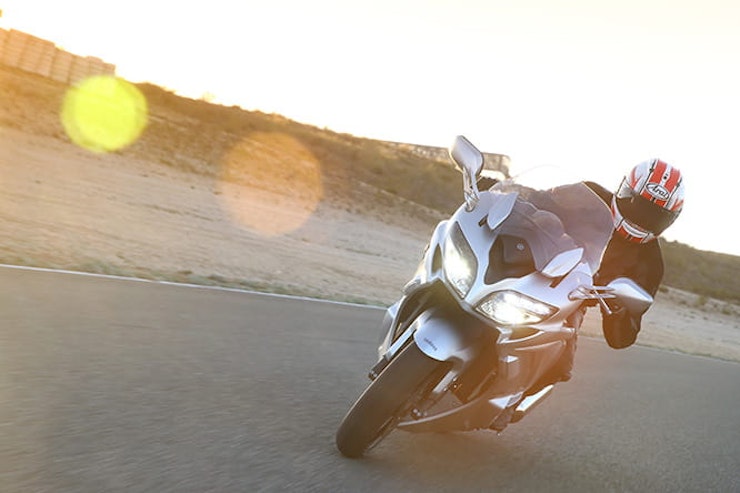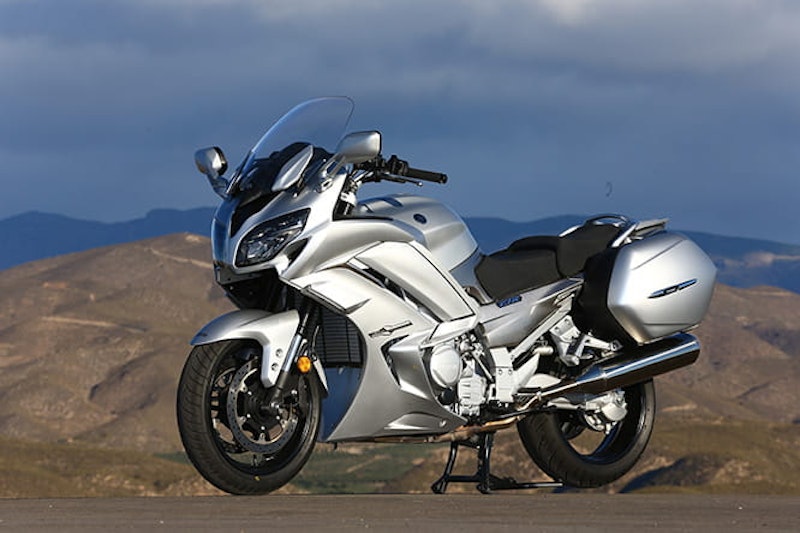Yamaha FJR1300 (2016) - Review
By Michael Mann
BikeSocial Managing Editor. Content man - reviewer, road tester, video presenter, interviewer, commissioner, organiser. First ride was a 1979 Honda ST70 in the back garden aged 6. Not too shabby on track, loves a sportsbike, worries about helmet hair, occasionally plays golf and squash but enjoys being a father to a 7-year old the most.
26.02.2016
Favoured by police forces and other emergency service couriers thanks to its reliability, range, comfort and performance, the sports-touring Yamaha FJR1300 gets a handful of technical tweaks for 2016 to boost the performance side and rideability. After all, Yamaha already know they have the touring ability covered.
The most important changes include an extra gear resulting in a revised gearbox and gear cog design plus the introduction of adaptive cornering lights. This technology allowing the rider to see a little further around a corner exists in the car world but is now sneaking onto two-wheeled transport, a similar concept to those seen on the KTM 1290 Super Adventure.
Other updates to the Euro4 compliant Yamaha are a new colour option, dashboard design tweaks, a redesigned tail unit plus LED lights all 'round and an Assist & Slipper clutch (A and AE models only) - more of which later.
However, what is important to point out is the price which remains the same as 2015; £13,299 (A), £14,799 (AE) and £15,499 (AS). Bike Social's Michael Mann has been riding the new FJR1300 at the press launch in Spain, both on road and on track believe it or not. All in the name of testing the bike's agility and performance plus those new cornering lights.
Yamaha introduced the world to their sports-cruiser in 2001 with its lightweight aluminium chassis flying in the face of other big, heavy tourers. The sportier approach and easier maneuverability made the bike an instant hit and, performance-wise, the original boasted the identical amount of power as the new, 5th generation version, of 144.2 bhp. Although 15 years after the FJR1300 was unveiled, the bike has gained around 10% torque from the mighty, shaft-driven, 1298cc, 4-cylinder engine.
And it’s the smooth power delivery and comfort over long distance which stand out as the Yamaha’s key benefits. 100,000 FJR1300’s have been sold since the launch which is testament to the model refinements coming from the Japanese manufacturer in 2003, 2006 and 2013. Updates over the years have included improved performance, safety, design and rideability.
So, what has been updated for the 2016 version?
6 speed gearbox: not only has the new model gained an extra gear, the gearbox size is no bigger thanks to the narrower, helical cut (diagonal instead of horizontal) gears resulting in a weight reduction of 400g. The torquey and powerful engine has longed for an extra gear to act as an overdrive for the longer tours. The engine’s rpm is also reduced by 10% as a result.
Adaptive Cornering Lights: LED lights all around mean less drain on the battery, important given the nature and purpose of the FJR with the likelihood of heated grips being used, sat nav systems and even phone chargers being added. The ACL system works with 3 LED’s lighting up one-by-one on each of the two headlamps starting at just 5 degrees banking. Tip the bike in purposefully and all three will light up together.
Redesigned tail section with LED rear lights and indicators.
Assist & Slipper Clutch: Yamaha says it creates a 20% lighter clutch operation and a smoother downshift.
Instrument panel: updated fonts and reflective coating reducing glare
New colour: Matt Silver joins the existing Tech Graphite as a new option
Of the three current models, the A, AE and AS – it’s the base spec ‘A’ that isn’t equipped with either the all-new cornering lights or electronic suspension and upside down forks. While at the other end, the ‘AS’ doesn’t require an Assist & Slipper clutch because since 2006 it’s had the YCC-S automatic shift system with no clutch lever. Gear changes can still be made by the regular foot-operated lever, or using the handlebar buttons.
We rode the AE model which has the electronically adjustable suspension operated via the handlebar mounted menu, displayed via the revised dashboard.
The roads around Almeria are perfect for motorcycling. Relatively empty with the odd gaggle of professional-looking cyclists, the stunning road quality matches the epic scenery – long views of mountains as the ribbon of tarmac sweeps around them looking like they’d been designed with testing motorcycles in mind. The fast sweepers and tighter yet still open, camber-favourable bends gave the FJR a proper workout. Climbing the mountain demonstrated the bike’s torque and power as well as the smooth throttle response and agility despite its 298kg weight…and that doesn’t include the rider. It’s no bother though because the application of power using the refined gearbox makes the FJR a handy tool for these roads. The engine has benefitted immensely from the extra gear and decreased rpm, making the bike more workable. With Yamaha even presenting the 6th gear as an overdrive, pulling away from slower corners, junctions or traffic lights are even easier than the previous model.
The new A&S clutch means less load on the springs and upside down forks on the downshift making corner entry easier and more stable. Thanks to the quality of the roads on the press launch, I opted to switch the electronically adjustable damping into ‘Hard’ then further adjusting it from to +2 (of the 7 finer adjustments to each of the three main suspension settings). Stiffening the bike on the smoother surfaces made the ride even more comfortable especially when picking up the pace. While the engine note and quality feel of power delivery seems sedate, you can easily become deceived by how quickly the Yamaha gathers speed. The FJR is a very capable bike and sportier than its appearance.
Spring preload can also be adjusted via the dashboard options. The number of helmets and luggage on the display determines the setting. For my 14 stone, 6 feet frame I opted for the one rider with luggage option to firm my ride up, handy when the road surfaces were this good. The dashboard options are controlled by a rocker switch on the left-side handlebar and a ‘Menu’ flick switch – options include the electronically adjustable windscreen height which moves quickly through its 130mm range. Though even at its highest setting offers complete protection for riders of around 5’10” and under (see images further down demonstrating the ful extent of the screen's highest and lowest positions).
Rider modes, known as D-mode in Yamaha speak, affect engine performance as opposed to the amount of power available. In ‘Touring’ mode, the range the electronic throttle butterfly opens differs giving softer performance in the mid-range than when in ‘Sport’. Impressively, though not a common occurrence among motorcycles with electronic rider options, the FJR stores your settings when you switch off the ignition and remembers them for next time you ride.
Speaking of luggage, all three models are equipped as standard with removable, key-operated and colour matched side cases. All three models still come with other goodies such 3-stage heated grips, traction control, two-seat height options (20mm range) and, new for 2016, all three are prepared for Dainese’s D-air system.
The big 320mm dual disc front brakes, assisted with ABS of course, provide excellent and stable stopping power which are more frequently on this shaft-driven FJR than a chain drive bike though I tended to use a little more rear brake on the way back down the mountain roads to prevent the front from pitching.
The Adaptive Cornering Lights were tested in the relatively safer environment of the Almeria circuit. The three-stage dual lights appear quickly with very little lean angle. It’s a very clever piece of technology that allow the rider to broaden their field of vision on the inside of a corner. This video offers a visual explanation:
VIDEO: Yamaha's FJR1300 Adaptive Cornering Lights:
A massive 25 litre fuel tank could offer a range of 250 miles if ridden sensibly, ideal for plenty of comfortable touring with an array of options to personalise the riding position, comfort, performance and agility of the bike. While on paper, an extra gear and some funky lights seems a mild model tweak, the design and capability of Yamaha’s popular sports-tourer just got dragged into the modern day making it a whole lot better than the outgoing version. Police forces and motorcycle couriers; get to your local dealerships.
TECHNICAL SPECIFICATION
KIT CREDITS
Helmet: Arai RX-7V
Helmet paint scheme: by Richard Stevens at RichART Concepts
Jacket & Trousers: Richa TG2 jacket and Richa TG1 trousers (Track)
Jeans: Resurgence Skinny Cafe Racer (Road)
Boots: S-Speed by TCX
Gloves: Alpinestars Oscar Robinson (Road)
Gloves: Savage Waterproof by RICHA (Track)
Do you own a current FJR1300? Give us a one-line review. or
Share on social media:

